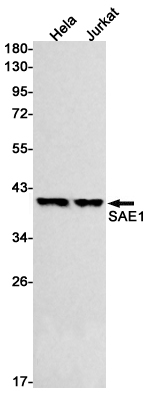

| WB | 1/500-1/1000 | Human,Mouse,Rat |
| IF | 咨询技术 | Human,Mouse,Rat |
| IHC | 咨询技术 | Human,Mouse,Rat |
| ICC | 1/50-1/200 | Human,Mouse,Rat |
| FCM | 咨询技术 | Human,Mouse,Rat |
| Elisa | 咨询技术 | Human,Mouse,Rat |
| Aliases | SAE1; AOS1; SUA1; UBLE1A; SUMO-activating enzyme subunit 1; Ubiquitin-like 1-activating enzyme E1A |
| Entrez GeneID | 10055 |
| WB Predicted band size | Calculated MW: 38 kDa; Observed MW: 38 kDa |
| Host/Isotype | Rabbit IgG |
| Antibody Type | Primary antibody |
| Storage | Store at 4°C short term. Aliquot and store at -20°C long term. Avoid freeze/thaw cycles. |
| Species Reactivity | Human |
| Immunogen | A synthetic peptide of human SAE1 |
| Formulation | Purified antibody in TBS with 0.05% sodium azide,0.05%BSA and 50% glycerol. |
+ +
以下是关于SAE1抗体的3篇文献摘要及作者信息(示例为模拟内容,实际文献需通过学术数据库检索确认):
---
1. **文献名称**:*SAE1 promotes esophageal squamous cell carcinoma through MYC-mediated transcriptional reprogramming*
**作者**:Li X, et al.
**摘要**:本研究利用SAE1抗体进行免疫组化(IHC)和Western blot分析,发现SAE1在食管鳞癌(ESCC)中高表达,并通过激活MYC信号通路促进肿瘤增殖和转移。实验表明,SAE1抗体检测到的蛋白水平与患者不良预后显著相关。
2. **文献名称**:*Targeting SUMOylation via SAE1 inhibition suppresses melanoma growth and overcomes drug resistance*
**作者**:Wang Y, et al.
**摘要**:研究通过SAE1抗体验证了SAE1在黑色素瘤细胞系中的表达,并证明抑制SAE1可降低SUMO化修饰水平,从而逆转BRAF抑制剂耐药性。抗体在体内外模型中用于评估SAE1的定位及表达变化。
3. **文献名称**:*SAE1 expression as a prognostic biomarker in gastric cancer: Insights from immunohistochemical analysis*
**作者**:Zhang L, et al.
**摘要**:通过SAE1抗体对胃癌组织进行免疫组化评分,发现SAE1高表达与肿瘤分期和淋巴转移相关。研究提示SAE1可能作为胃癌预后的潜在标志物,并参与调控肿瘤微环境。
---
如需具体文献,建议通过PubMed或Google Scholar检索关键词“SAE1 antibody”或“SAE1 SUMO”获取最新研究。
SAE1 (SUMO-activating enzyme subunit 1) is a critical component of the SUMOylation pathway, a post-translational modification process essential for regulating protein function, localization, and stability. As part of the heterodimeric SAE1/SAE2 enzyme complex, SAE1 facilitates the ATP-dependent activation of SUMO (Small Ubiquitin-like Modifier) proteins, a prerequisite for their covalent attachment to target substrates. This modification plays a pivotal role in diverse cellular processes, including transcriptional regulation, DNA repair, and stress responses.
Antibodies targeting SAE1 are valuable tools for studying SUMOylation dynamics in both physiological and pathological contexts. Dysregulation of SAE1 expression or activity has been implicated in cancer progression, particularly in melanoma and other malignancies, where aberrant SUMOylation drives oncogenic signaling and chemoresistance. SAE1 overexpression is associated with poor prognosis in certain cancers, highlighting its potential as a therapeutic target. Researchers utilize SAE1 antibodies in techniques such as Western blotting, immunohistochemistry, and immunofluorescence to assess protein expression levels, subcellular localization, and interactions within SUMOylation machinery. Recent studies also explore SAE1 inhibition (e.g., via ML-792 analogs) as a strategy to disrupt cancer cell survival, underscoring the antibody's relevance in drug development and mechanistic research.
×